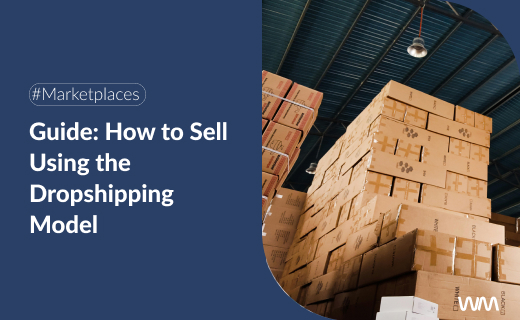What is Dropshipping?
Dropshipping is a business model that allows entrepreneurs to sell products without handling inventory or managing shipping. This model works by acting as an intermediary between buyers and suppliers, enabling direct sales without the risks of investing in products upfront.
How Does Dropshipping Work?
The dropshipping process is quite simple and consists of three main steps:
- A customer purchases a product from your online store or marketplace profile.
- You buy the product from the supplier at a wholesale price.
- The supplier ships the product directly to the customer on your behalf, often with the option to customize the packaging or labeling.
This model eliminates the need for physical storage, reducing fixed costs and risks.
Advantages of Dropshipping in 2025
Dropshipping offers multiple benefits, making it an attractive option for entrepreneurs who want to start an online business without large upfront investments or expand their existing product portfolio without buying stock.
Low Initial Investment
Since you don’t need to purchase inventory in advance, dropshipping is ideal for those starting with a limited budget.
No Need for Product Storage
You don’t have to manage or store products, significantly reducing operational costs.
Scalability
You can easily expand your business without the limitations of physical inventory. Dropshipping allows you to sell products in different markets with minimal hassle.
No Risk of Unsold Inventory
Because you only buy the product after receiving an order, there’s no risk of holding excess stock.
Disadvantages of Dropshipping
Despite its advantages, dropshipping also has some drawbacks that every entrepreneur should consider.
Low Profit Margins
Profit margins are generally lower than in other business models, making long-term profitability difficult without a high sales volume.
Supplier Dependency
Your success relies on the quality and reliability of your suppliers. A shipping error or stock shortage can negatively affect your reputation.
Fierce Competition
Due to low entry barriers, competition in many niches is intense, requiring effective marketing strategies—which often means additional investment.
How to Start a Successful Dropshipping Business
If you’re ready to start your dropshipping business, follow these steps to ensure success.
Choose a Profitable Niche
Selecting a profitable niche is crucial to avoid excessive competition and ensure a stable demand for your products. Research trending products using platforms like Google Trends and Amazon.
Find Reliable Suppliers
It’s essential to choose trustworthy suppliers who offer quality products, reasonable shipping times, and competitive prices. While many platforms are available, you should always verify a supplier’s reliability.
Create Your Online Store
To sell via dropshipping, you need an online store. Platforms like Shopify and WooCommerce make it easy to set up your store.
Define Your Digital Marketing Strategy
Digital marketing is key to driving traffic. Use SEO techniques, advertise on platforms like Facebook and Google Ads, and leverage email marketing to retain customers.
Provide Excellent Customer Service
Customer service plays a crucial role in customer retention. Respond quickly, handle returns efficiently, and maintain clear communication.
Is Dropshipping Worth It in 2025?
Despite its challenges, dropshipping remains a viable option for those entering e-commerce with limited initial investment. While profit margins may be low, a well-planned marketing strategy, combined with a strong niche and reliable suppliers, can help your business grow effectively.
Additionally, you can minimize your initial investment and risks by optimizing your cash flow. If you don’t have significant capital but want to scale quickly, you can receive daily payouts for your marketplace sales with Wannme. Instead of investing your own money in ads and marketing, you can reinvest the earnings from your sales to grow faster.
Integrating Dropshipping in Marketplaces Like Amazon to Scale Rapidly
If you’re already selling on a marketplace like Amazon and want to expand your catalog without the risks and costs of managing inventory, integrating dropshipping is a great strategy for scaling your business. Dropshipping allows you to work with suppliers who handle storage, packaging, and shipping directly to customers. This flexibility enables you to offer a wider range of products without investing in inventory or logistics.
A great example is Amazon and its FBA (Fulfillment by Amazon) program. With its extensive sales policies and logistics network, Amazon provides an ideal ecosystem for dropshipping. This approach is especially useful when selling across multiple Amazon marketplaces, as it helps meet each region’s shipping and regulatory requirements.
However, it’s crucial to choose suppliers that meet strict delivery deadlines and have clear return policies. Additionally, ensure that the products you sell comply with marketplace quality standards and consumer expectations. While dropshipping reduces business entry barriers, you’ll still need to manage customer service and optimize your store to maintain a strong reputation.
Summary
Dropshipping is an accessible business model, but success depends on choosing the right niche, working with reliable suppliers, and implementing a strong digital marketing strategy. If you’re ready to tackle the challenges and take advantage of its benefits, 2025 could be the perfect year to start your dropshipping business.
Additionally, there are financial strategies to accelerate your growth. Unlock a cash flow hack by receiving daily payouts for your marketplace sales from the past 24 hours. This allows you to reinvest faster and scale efficiently. Want to know more? Contact us today!
Follow us on LinkedIn and subscribe to our newsletter for the latest insights!






